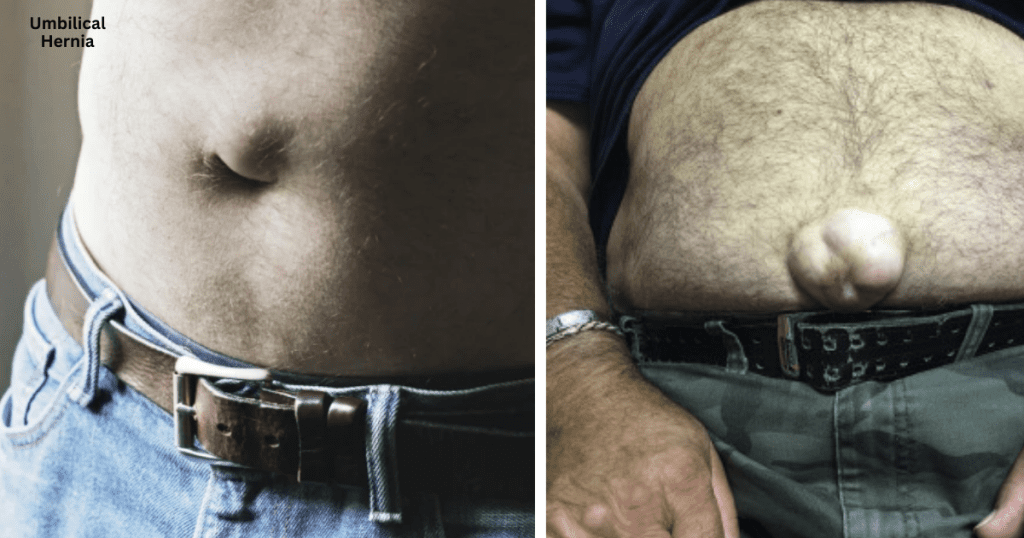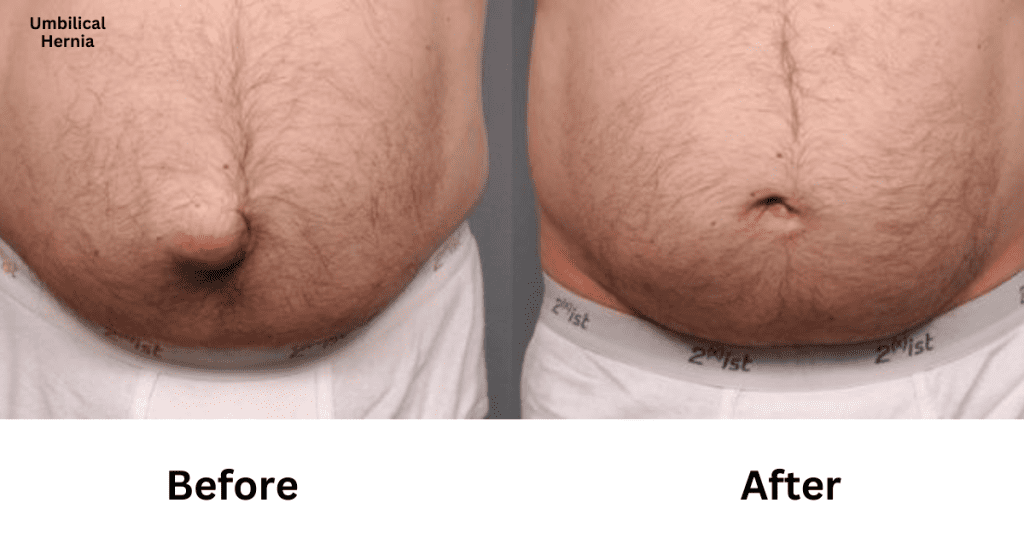Umbilical hernia is a condition that occurs when part of the intestine or fatty tissue bulges through a weak spot in the abdominal wall near the belly button (umbilicus). This condition is common in both infants and adults, with varying levels of severity. While in many infants, umbilical hernias close naturally, in adults, they typically require surgical intervention, especially when causing discomfort or leading to complications. One of the most advanced and effective methods for treating umbilical hernias is laparoscopic surgery, a minimally invasive procedure that has significantly improved patient outcomes. At Surgikure in Vizag, laparoscopic surgery is offered as a leading option for umbilical hernia repair, providing patients with modern care and faster recovery times.
Understanding Umbilical Hernias
Causes
An umbilical hernia is formed when abdominal organs or tissues bulge through the abdominal muscles near the belly button. In newborns the cause may be due to the inadequate fusion of the umbilical ring once the baby is born. In adults, the condition can be caused by:
- Increased abdominal pressure: This is usually as a result of factors like obesity, pregnant women, those with a chronic cough or those persons who are involved in any form of strenuous activities like lifting heavy objects.
- Weak abdominal muscles: In the course of a life, various serious changes happen to the organism, for instance, weakening of the stomach muscles, which is a major cause of hernias in the elderly.
- Previous abdominal surgeries: Operations such as cesarean section or any other operations that compromise the integrity of the abdominal wall makes one develop hernias.


Symptoms
An umbilical hernia normally manifest itself in form of a lump around the navel area. Other symptoms include:
- Pain or discomfort: This pain may worsen with physical activities, coughing or when lifting any given weight or object.
- Swelling or tenderness: In some networks there is significant increase in the size of the hernia particularly when standing or when in a strained position.
- Changes in appearance: An out hanging belly button, or even a swollen part in the abdominal region.
Sometimes the hernia can become strangulated or incarcerated, which results to severe abdominal pains, nausea and vomiting and usually requires emergency surgery when there is a risk of bowel strangulation.
Risk Factors
While anyone can develop an umbilical hernia, several factors increase the likelihood:While anyone can develop an umbilical hernia, several factors increase the likelihood:
- Infants and young children: Newborns, preterm babies or babies with low birth weights are part of the vulnerable persons.
- Obesity: Extra fat on the body burdens abdominal muscles putting them under pressure.
- Pregnancy: The enlarge uterus also puts more pressure on the muscles of the abdomen thus making them weak.
- Chronic conditions: For instance includes COPD, ASCITES, persistent coughing and others.
What is Laparoscopic Surgery?
To correct the hernia, the surgeon performs a technique known as laparoscopic surgery which is also referred to as minimally invasive surgery. There are several advantages of this technique over open surgery which are widely accepted by the patients. In umbilical hernia repair the surgeon uses one laparoscope that has both a camera and a working channel through which the surgeon places the required instruments through separate small incisions to directly see the hernia and then fix the abdominal wall.
The Procedure: Step-by-Step
- Anesthesia: To avoid any forms of pain during the surgery, the patient is put under general anesthetic, thus making the process easier.
- Small Incisions: Small multiple incisions are made measuring between 5-10mm and they are mostly located around the umbilicus. These cut are smaller than the cut made during the conventional surgical operations known as open surgeries.
- Insertion of Laparoscope: The first one involves the use of a laparoscope that has a high definition camera that is inserted through one of the incisions. By so doing the camera gives the surgeon a clear view of the internal organs.
- Repairing the Hernia: With the help of the developed instruments, the Surgeon repositions the fatty tissue back to its original position after which the surgeon protrudes the mesh to support the abdominal wall. The mesh performs the role of reinforcement in order to avoid the relapse of hernia.
- Closing the Incisions: After the hernia surgery, the cuts are then stitched or glued to close the operative area. These are small incisions and it therefore means that scarring is extremely limited.


Advantages of laparoscopic technique to treat Umbilical Hernia
Laparoscopic surgery has become the preferred method for umbilical hernia repair due to the many advantages it offers over traditional open surgery:
- Smaller Incisions and Less Scarring: The benefits arising from the procedure include are that it is less invasive than the open technique in that it leaves behind small incisions hence less scarring.
- Reduced Pain: Patients having undergone laparoscopic surgery also take shorter time to recover from the operation than those who undergo open surgeries since the procedure is less invasive hence minimal post-surgery pain.
- Faster Recovery: The recovery time after the laparoscopic surgery is less as compared to the conventional methods of surgeries. Majority of patients can resume their normal activities within 1-2 weeks as opposed to other surgical procedures that may cause a longer recovery time such as the open surgeries.
- Lower Risk of Complications: Less invasive surgical procedures are known to be less likely to develop complications such as infections, bleeding amongst others.
- Same-Day Discharge: The majority of patients who have gone through laparoscopic surgeries are often discharged directly upon the completion of the surgery hence are suitable for patients who desire to avoid hospitalization as much as possible.
Recovery and Post-Operative Care
After umbilical hernia laparoscopic surgery, patients can expect a relatively quick recovery process:
- Rest and Activity: After the surgery patients are supposed to stay home and limit their physical activities for the first 48 to 72 hours. However, a simple walk and other light activities should be performed in order to avoid formation of blood clots in the lower limbs.
- Pain Management: Most of the times, the pain can be managed with the use of drugs available without a prescription. If the pain is severe and cannot be controlled by over-the-counter medication, prescription pain medications may be given.
- Follow-Up Appointments: An appointment with the surgeon is then book to have the dressings changed a week or two after the surgery.
- Returning to Work: It also explained how the majority of people are able to go back to work at one to two weeks’ notice after receiving the vaccine and on the basis of their workplace and physical tasks.
- Long-Term Outlook: When adequate post-operative care is accorded, about 98% of patients who undergo laparoscopic hernia repair operations do well and there is low incidence of recurrence.
Potential Complications
Although laparoscopic umbilical hernia surgery is considered safe, there are still some risks involved, including:
- Infection: Aside from this there are always complications that come with any type of surgery and this includes infection of the incision area.
- Bleeding: Some cases can result into minor bleeding but in most cases they can be handled easily.
- Hernia Recurrence: However the risk as we know when carrying out laparoscopic surgery there is an indication that the hernia might reoccur.
- Bowel Injury: Occasionally the intestines or any other organs may be injured due to the surgery; this will then requires further surgeries.
Patients should know when a complication may be arising, for example when one is experiencing sever pain, increased size of the tumor, fever or persistent nausea they should seek medical attention immediately.
Conclusion
Laparoscopic treatment of umbilical hernia provides an effective technique for the management of hernias with shorter hospital stay, minimal postoperative complications. Through this technique of surgery, the patients can have less pain, they are left with little or no scar and can get back to their normal activities very soon. If ever you have signs or if ever you are thinking about having umbilical hernia surgery, Surgikure in Visakhapatnam and Vijayawada stands ready to ensure you get all the help and knowledge that will simplify diagnosis, treatment, and future recovery.
